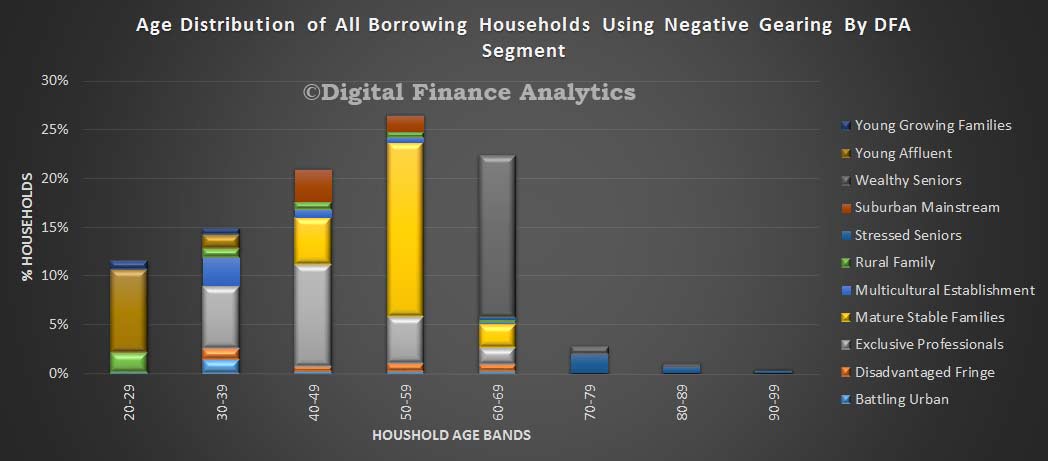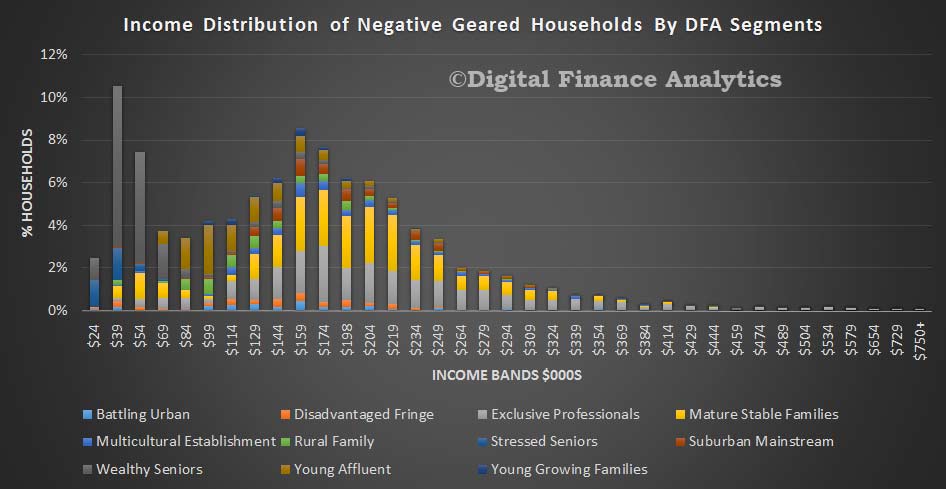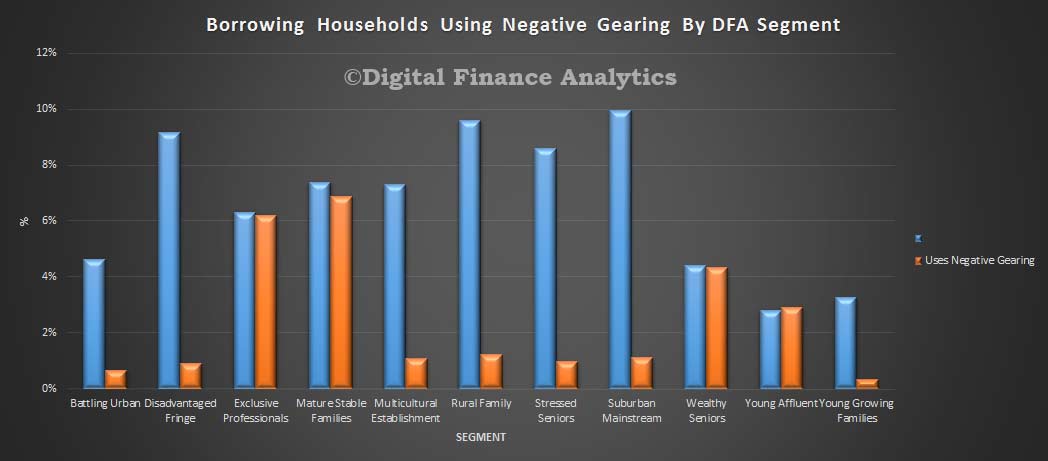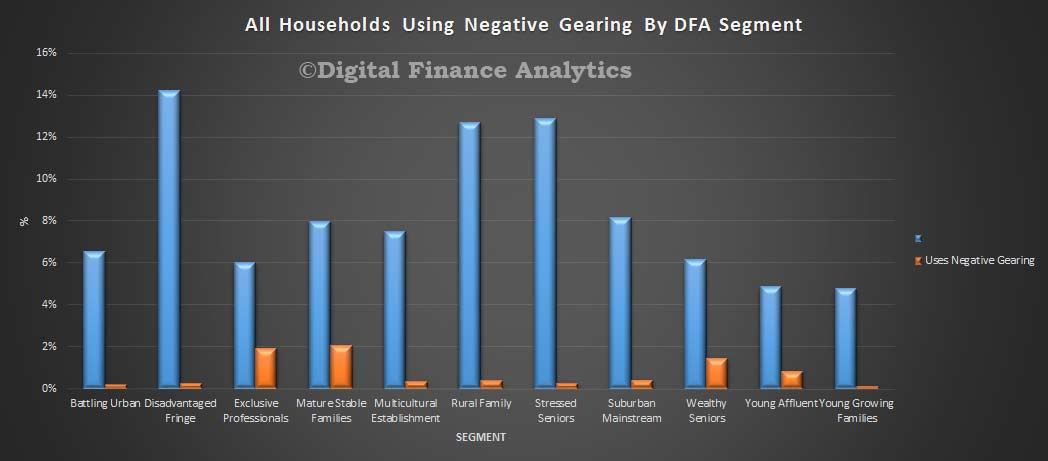Labor have announced proposals to change the negative gearing and capital gains tax rules relating to property investments. In an interview today on ABC Insiders, Chris Bowen, Shadow Treasurer said that negative gearing would potentially only be available on new property in 2017 , currently half of the benefit goes to top income earners, and proposes changes to CGT concessions, referring to the Murray FSI recommendations. 70% of benefit he says goes to top income earners. What “top” means was not defined.
Expect to see more tax reform shots exchanged as we progress through the year.
We decided to pull data from the DFA household surveys, to examine the distribution of negative gearing. Our segmented surveys, show some of the nuances in behaviour. We start with age distribution. We find that households of all ages may use negative gearing, but more than a quarter are aged 50-59. We see the DFA household segmentation in evidence, with a number of young affluent households active aged 20-29, especially using an investment property as an alternative to buying their own place to live. We discussed this before. As we progress up the age bands, we see a strong representation by the more affluent segments, including mature stable families and exclusive professionals. In later life, wealth seniors are also active, especially in the 60-69 year bands. So negative gearing is being used by households across all age groups.
 Then we looked at distribution, by segment, across the income bands. The horizontal scale shows the upper cut-off in each band, for example, the first is up to $24,000. Wealth seniors, with lower incomes are well represented in the lower income bands, but as income rises, we see a mix of households using negative gearing. What is true, is that there is a greater proportion of households in the $100-$200k band. Above that, there is a fall in all households represented, but we see those with very large incomes still represented to some extent. Again we see our segments highlighting the strong presence of exclusive professionals and mature stable families.
Then we looked at distribution, by segment, across the income bands. The horizontal scale shows the upper cut-off in each band, for example, the first is up to $24,000. Wealth seniors, with lower incomes are well represented in the lower income bands, but as income rises, we see a mix of households using negative gearing. What is true, is that there is a greater proportion of households in the $100-$200k band. Above that, there is a fall in all households represented, but we see those with very large incomes still represented to some extent. Again we see our segments highlighting the strong presence of exclusive professionals and mature stable families.
 If we then look specifically at borrowing households using negative gearing, as compared to all households in the segments, the picture is quite striking. In our most affluent segment – exclusive professionals, nearly half are using negative gearing for property investment. Wealth seniors and mature steady state families are also well represented. But the most striking observation is that among young affluent households more than half are geared. Other segments are less represented.
If we then look specifically at borrowing households using negative gearing, as compared to all households in the segments, the picture is quite striking. In our most affluent segment – exclusive professionals, nearly half are using negative gearing for property investment. Wealth seniors and mature steady state families are also well represented. But the most striking observation is that among young affluent households more than half are geared. Other segments are less represented.
 The final picture is all household, compared with those negatively geared. We see a concentration in the more affluent segments, and other segments where negative gearing hardly exists.
The final picture is all household, compared with those negatively geared. We see a concentration in the more affluent segments, and other segments where negative gearing hardly exists.
 So, our survey suggests that negative gearing, whilst it is spread across the income bands, is indeed concentrated among more affluent households. Four segments, exclusive professionals, mature steady state, wealthy seniors and young affluent households contain the lions share of negative geared investment property. These segments are at different life stages, have different income profiles, and different strategies. For example the young affluent are often using investment property as a potential on-ramp to later owner occupied purchase, whereas wealthy seniors are all about income, and the others more wealth creation.
So, our survey suggests that negative gearing, whilst it is spread across the income bands, is indeed concentrated among more affluent households. Four segments, exclusive professionals, mature steady state, wealthy seniors and young affluent households contain the lions share of negative geared investment property. These segments are at different life stages, have different income profiles, and different strategies. For example the young affluent are often using investment property as a potential on-ramp to later owner occupied purchase, whereas wealthy seniors are all about income, and the others more wealth creation.
This analysis shows how complex the true situation is. Prospective changes are likely to impact different segments in diverse ways and there is plenty potential for spill-over impacts and unintended consequences. But the truth is, most negative gearing resides among more affluent households. The current settings are not correct.
In the RBA’s submission to the Inquiry on Home Ownership, they argue that negative gearing for investment property should be reviewed, because it has the potential to raise risks in the market, lift prices and distort the market.
The UK has just reduced the opportunity for negative gearing, there, and the Grattan Institute also makes a strong case for change.

One thought on “Fact Check On Negative Gearing, Using DFA Data”